By Tanya Kelley
Recently, my neighbor surveyed our pasture, noticing the difference from the brushy, overgrown mess it had been five years ago. He said, “Your sheep have done a really good job of cleaning up the pasture!”
That took me back a few years, to 1994, the year we first got our sheep. I’d been warned about all the problems with sheep — hoof rot, lambing problems, docking tails, prolapsed uteruses, poor mothering abilities and the fact that they were coyote bait. But our horses and cows were picking around all the things they didn’t like in the pasture. Someone told me goats and sheep would eat what the horses would not.
Then, I saw a post-it note ad for a pair of Shetland sheep on the bulletin board at the local grocery store. At that point, I figured sheep were sheep and one breed wasn’t going to clear out the pasture better than any other.
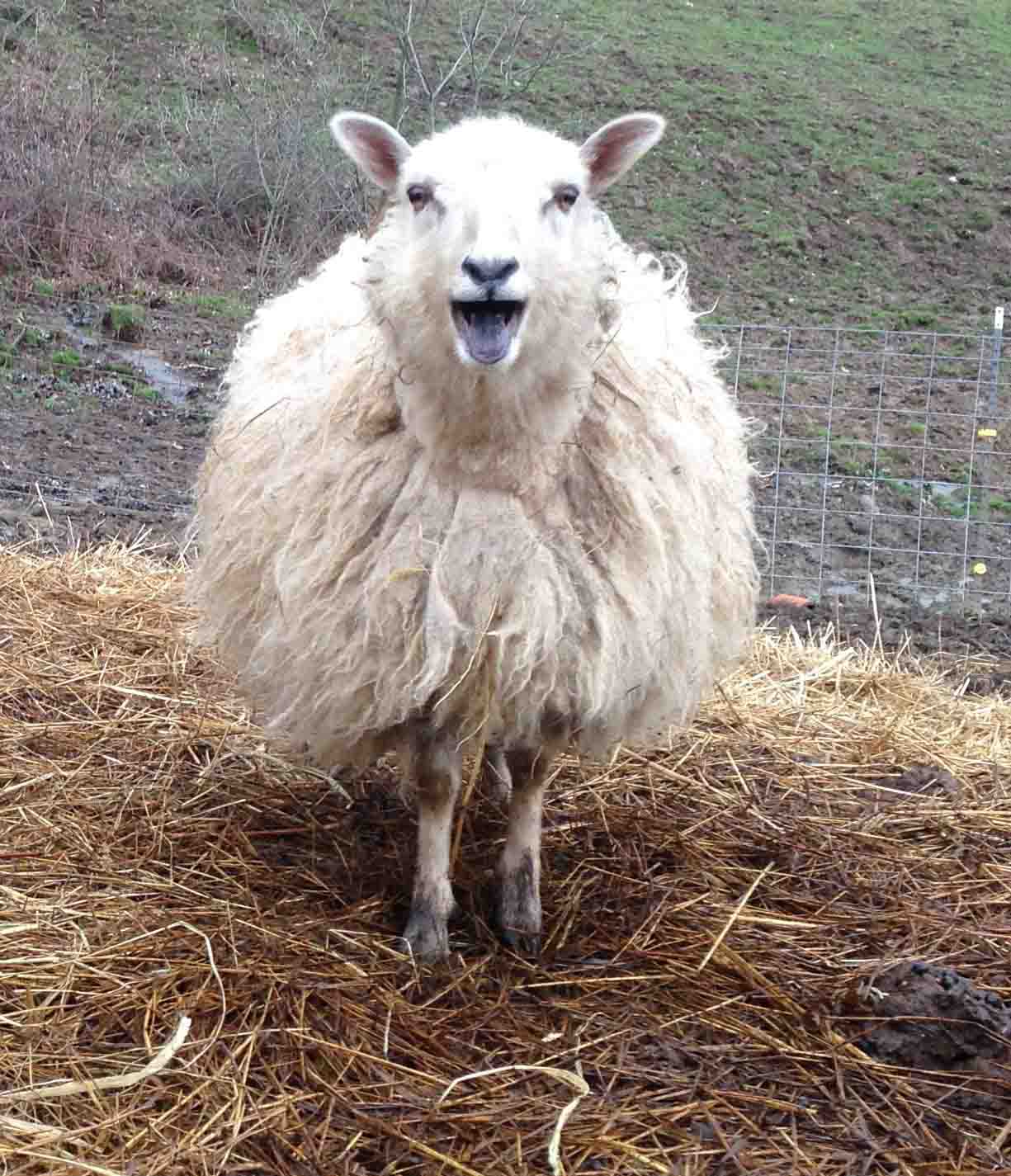
Shetland sheep are a primitive, unimproved breed of sheep in the northern shorttail sheep group. They defy most common sheep lore, being hardy, healthy, and self-sufficient. They thrive outdoors in most locales, and produce excellent quality fleeces that are prized by handspinners and fiber artists due to their very fine, soft wool. Their small size makes them particularly suited to handling by smaller homesteaders.
And there was truth to that — the sheep didn’t clean up much in our pasture. Neither have they cleaned up our current pasture (like my neighbor believed), but that’s another story. Goats browse on weeds. Sheep prefer grass, just like cows and horses.
The sheep failed at their intended jobs, but they still proved to be a valuable addition to the homestead.
Shetlands are a primitive, unimproved breed so all the warnings I’d been given didn’t apply. They are hardy and self-sufficient. They are gentle and affectionate but will also stand their ground with predators. I haven’t lost one to coyotes, even though there have been plenty of coyotes around. Shetland rams usually weigh 90 to 125 pounds and ewes about 75 to 100 pounds, so even small shepherds can handle them with ease. Carcasses are small, but good eating. They are excellent mothers and lamb with ease. No tail docking either — their tails are naturally six inches or shorter. Best of all, they make a crimpy, fine wool — so fine that they are used to make wedding shawls that can pass through a wedding ring.
Buying your Shetland sheep
It’s probable that Vikings introduced sheep to the Shetland Islands over 1,000 years ago. Those sheep are the ancestors of today’s Shetland sheep. In 1980, the first Shetland sheep were imported to Canada. Today, there are 2,879 flocks registered with the North American Shetland Sheepbreeders Association (NASSA) — making it easy to find Shetland sheep in your area.
Once you’ve found your sheep prospect, apply the same common sense rules as when buying any livestock. Sheep should have bright eyes, walk sound and have clear breathing. The jaw shouldn’t be overshot or undershot. Check rams for two testicles of approximately the same size. Check ewes (especially if currently nursing) for unevenness or lumps in the udder. See if the seller has registration papers and examine the parents, if possible. Examine vaccination and worming records and get a copy, if available. Unlike cows, a sheep that twins is a good thing — it increases your flock size twice as fast. A twin lamb has a much greater chance of producing twins itself.
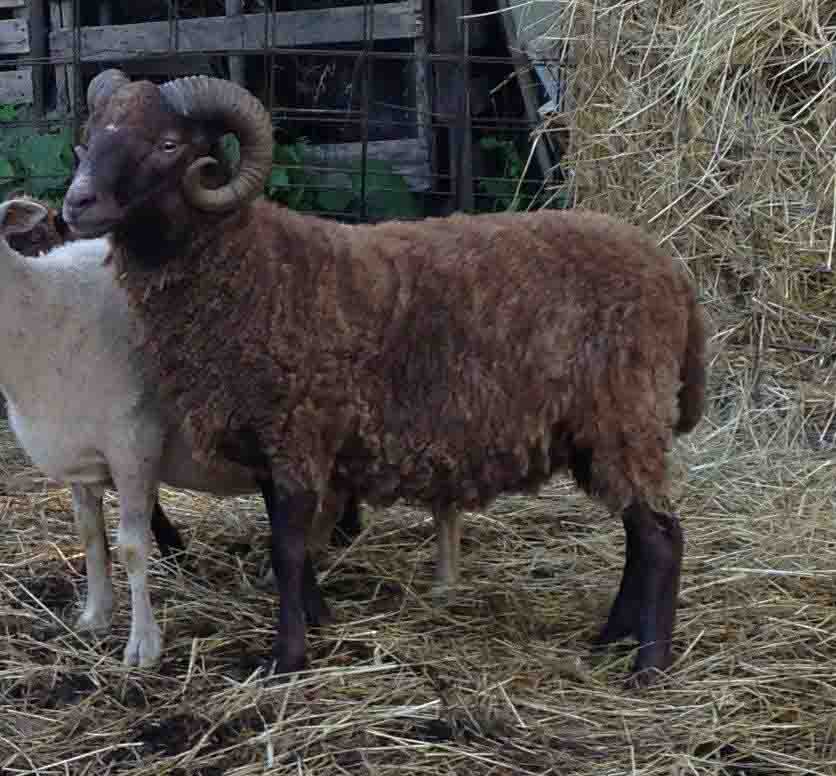
Shetland sheep come in many colors, from white to silver to caramel to black, and many variations between, including spotted and with other markings.
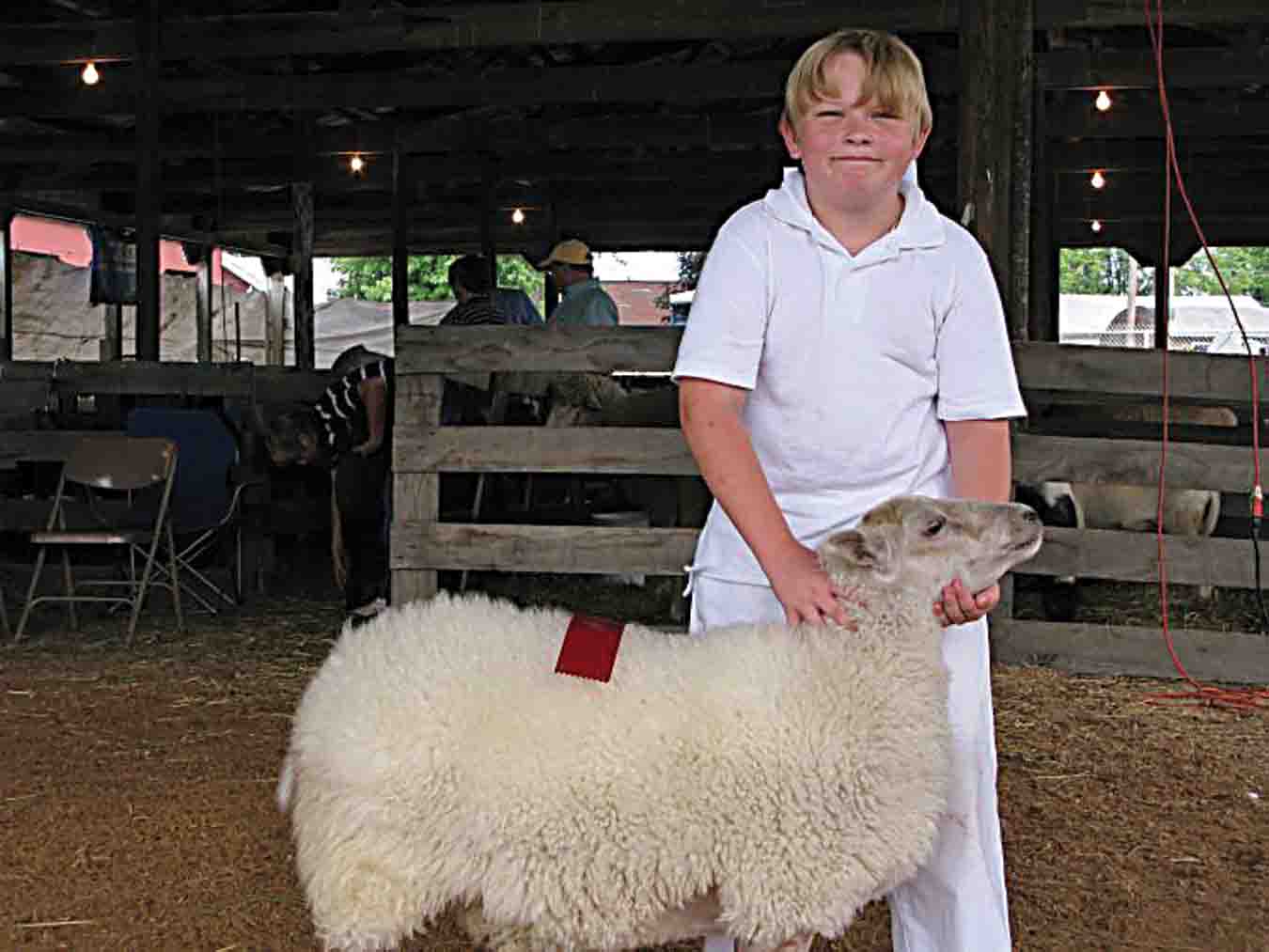
Shetland sheep come in many colors, from white to silver to caramel to black, and many variations between, including spotted and with other markings.
After you’ve covered the typical livestock buying process, there are a few more sheep-specific checks. The sheep’s fleece should not be ragged. It should not break off when you hold a lock on each end and give it a sharp snap. Breaks indicate a shock to the sheep — such as an illness/fever or bloat. Fleece should be crimpy, ideally with several crimps to the inch. It should feel soft (although probably dirty and slightly greasy). Lamb’s wool is going to be very soft, a mature ewe’s wool not as soft, and a ram’s wool tends to be coarser.
There are also things to keep in mind that are specific to the Shetland breed. First, mature Shetland sheep are often a different color than stated on their papers (if registered young). We have had several black lambs that sheared out, revealing a lovely silver ram underneath. And some delicious looking chocolate-colored rams that sheared out to look like cinnamon sugar. Shetlands can be almost any color (even spotted) and there are often surprises on shearing day!
Look for the Shetland to have small, fine ears and to be fine boned. They have wool on their foreheads, but not over their eyes. The head should be not too large as this tendency may be passed on to their lambs, leading to lambing difficulties.
It’s difficult to tell with young rams, but with older rams, determine the path the horns will take as they spiral. If the horns are curving so they are on course to grow into the head or neck, you’re looking at a future freezer camp resident, not a quality breeding ram. In addition to the growth path, horns should be evenly spiraled and of similar thickness. Occasionally, a ewe will have horns.
It’s always a good idea to get a signed bill of sale, with a description of your purchase, including registration number (or its parents’ numbers) and purchase date. Sellers are usually responsible for transferring and paying the fees for NASSA registered sheep. Most sales happen without issue, but detailed information makes it easier to resolve any issues should they arise.
Feeding
Once you have your charges home, the fun begins. Sheep are ruminants so they will tolerate feed issues better than a horse but they still require proper feeding.
Sheep cannot tolerate copper. You must read your feed labels! Nearly all livestock feed contains copper — that includes many goat feeds. Mineral blocks for most livestock contain copper as well. Copper will kill your sheep. If you have mineral blocks out for your horses and cows, you must make them inaccessible to the sheep — and yes, the sheep will make a beeline for them, if they know they are there. Buy sheep feed and make sure you get minerals that are specifically for sheep (read the label!).
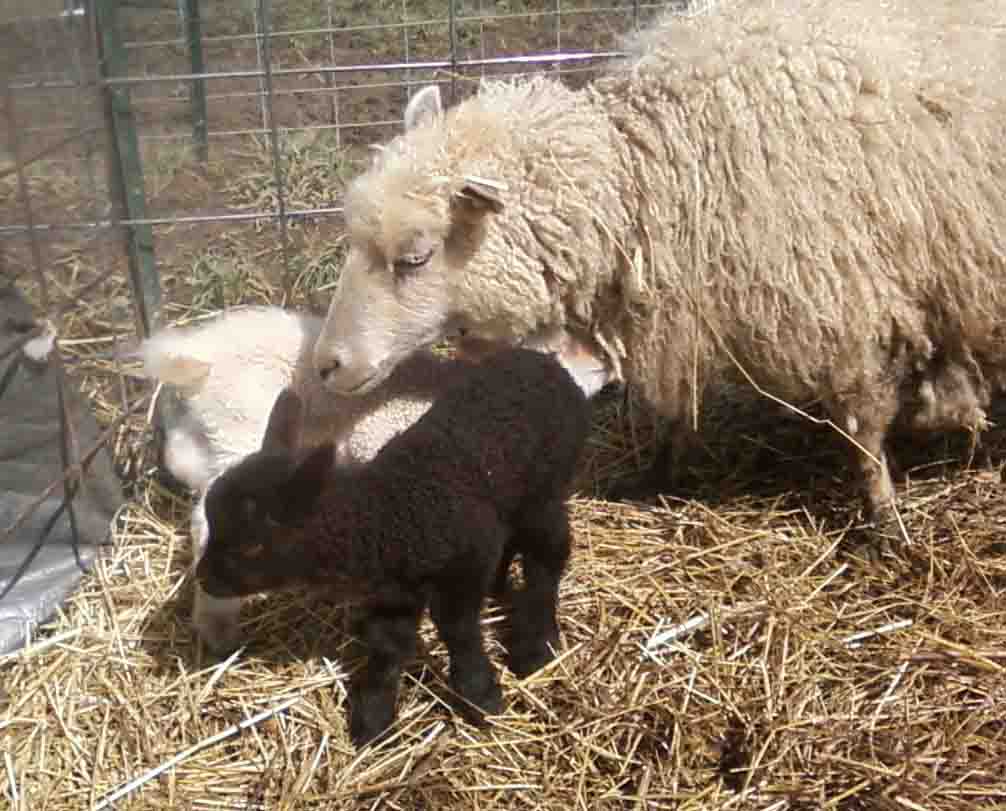
Shetland ewes like this one typically lamb easily and are good mothers. Twin lambs are more likely to produce twins themselves; that’s a desirable trait, no matter if your goal is to produce wool, meat, or sheepskins. More lambs equals more potential profit and a better selection of animals from which to pick replacement ewes.
Change feed gradually. If your sheep have been eating last year’s grass hay round bale and you suddenly turn them out on lush, clover-filled pasture, you’re going to see bloated sheep. At best, you’ll end up with a hefty vet bill. Or worse, you’ll be holding some ovine funerals. Turn sheep out on new pasture for 15 minutes the first day and bring them in. The next day, let them graze for 30 minutes, the third day for an hour and the fourth day for two hours. After that, they are good to stay out. The goal is to build up their tolerance and to keep them from glutting themselves.
Our sheep live on pasture in the summer and plain grass hay round bales or haylage bales during the winter. Sheep usually avoid eating poisonous plants in the pasture unless there is no other food. Watch your sheep — if they are grazing areas they normally avoid or if they seem hungry, it’s probably time to start feeding hay.
Make grain changes or increases gradually. Mix ¾ of the old ration with ¼ of the new feed for the first day. On the second day, mix ½ and ½. The third day mix ¾ of the new feed and ¼ of the old feed. By the fourth day, feed 100% of the new feed. If increasing feed, increase by about a cup per day.
Let the condition of the sheep determine when they need grain — so feel your sheep. It’s difficult to see a starving sheep under four inches of wool. Feel their backs and ribs; if you don’t feel a good padding of fat, it’s time to grain them. Nursing ewes and sheep that don’t have a lot of area to graze can go downhill very fast.
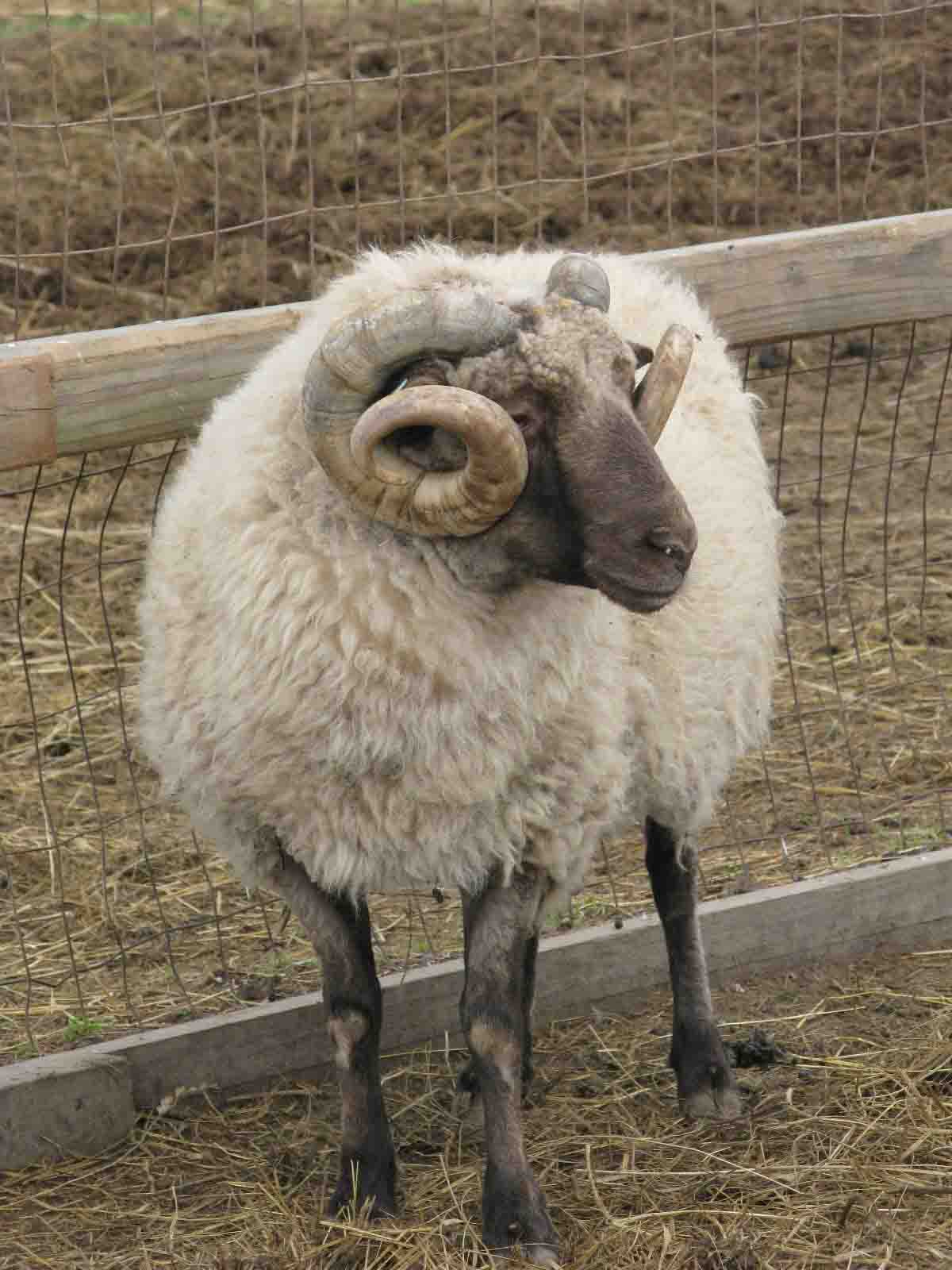
This ram’s horns are a good example of desirable horn paths. They are symmetrical, curve uniformly, and will not grow back into the rams skull or eyes. Rams who have horns which will obviously eventually kill them should never be used for breeding.
Health care
We vaccinate twice a year, as per our veterinarian’s recommendations. Your best information on vaccinations needed and worming schedules for your region will be your local veterinarian. He can also advise you of common medications you might want to keep on hand — it can mean the difference between a phone call to your vet in the middle of the night, verses an expensive emergency vet call.
We also check our sheep feet twice a year. They rarely require trims but sometimes they wear unevenly so we trim them up. We want both toes of each foot level and the hoof wall even with the sole.
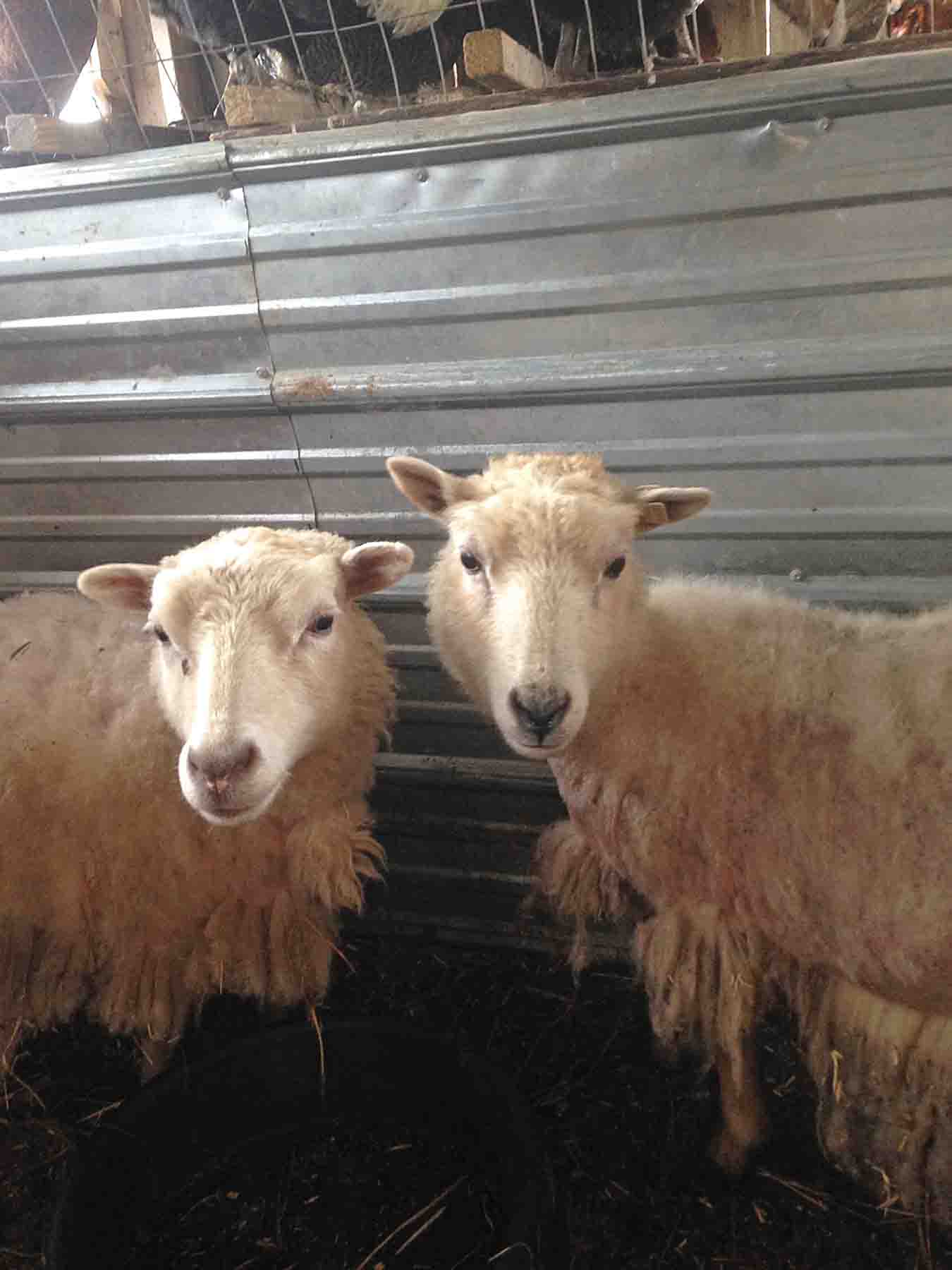
These ewes are rooing — that is, their wool is falling off naturally. If your goal is only to produce meat, you might find this acceptable in your flock, however wool or sheepskin producers will want to select against this trait, which severely decreases the quality of fiber.
Usually, if sheep are up and eating, they are fine. If a sheep is down, breathing hard and not interested in food, she is probably very sick.
I check for changes in manure, breathing (12-20 breaths a minute is normal), pulse (70-80 beats per minute) and temperature (102.3 is normal). Any temperature over 104 indicates there is an infection. If anything seems significantly off, I call my vet.
Housing and fencing
We have kept sheep in electric fence and if they are freshly sheared when introduced to the fence, it works. Once they are covered in wool, they don’t even know the fence is there. Right now, our sheep are fenced in by hog panels. It works great for the big sheep, but young lambs are naughty and will squeeze through the openings.
Thick wool protects Shetland sheep from even the worst weather. I know many people that have kept their Shetland sheep outside with only woods for shelter. Their sheep thrived. Ours are spoiled, with their own shed and an indoor hay rack. Sheep that are kept outside tend to make better and thicker wool, while the inside sheep make somewhat lighter coats.
Inside or outside, sheep need to have a relatively dry area. Unlike many other sheep breeds, Shetland sheep are resistant to foot rot (from standing in mud) but they still won’t tolerate mud as well as cows do.
I don’t know if rams are called “rams” because they ram things or if we say something has been rammed because it is as if a ram hit it. Either way, rams ram things — especially good, solid barn doors that you wanted to keep on the barn. After enough rams, nearly any barn door gives way. However, if a ram can’t make the battle charge all the way to the door, it’s just not worth doing. A 4×4 or a landscape timber on the ground, about eight inches from the door ruins all the fun. If need be, we put in stakes to secure it. We lost numerous barn doors before we accidentally stumbled across this trick — but not a single one since.
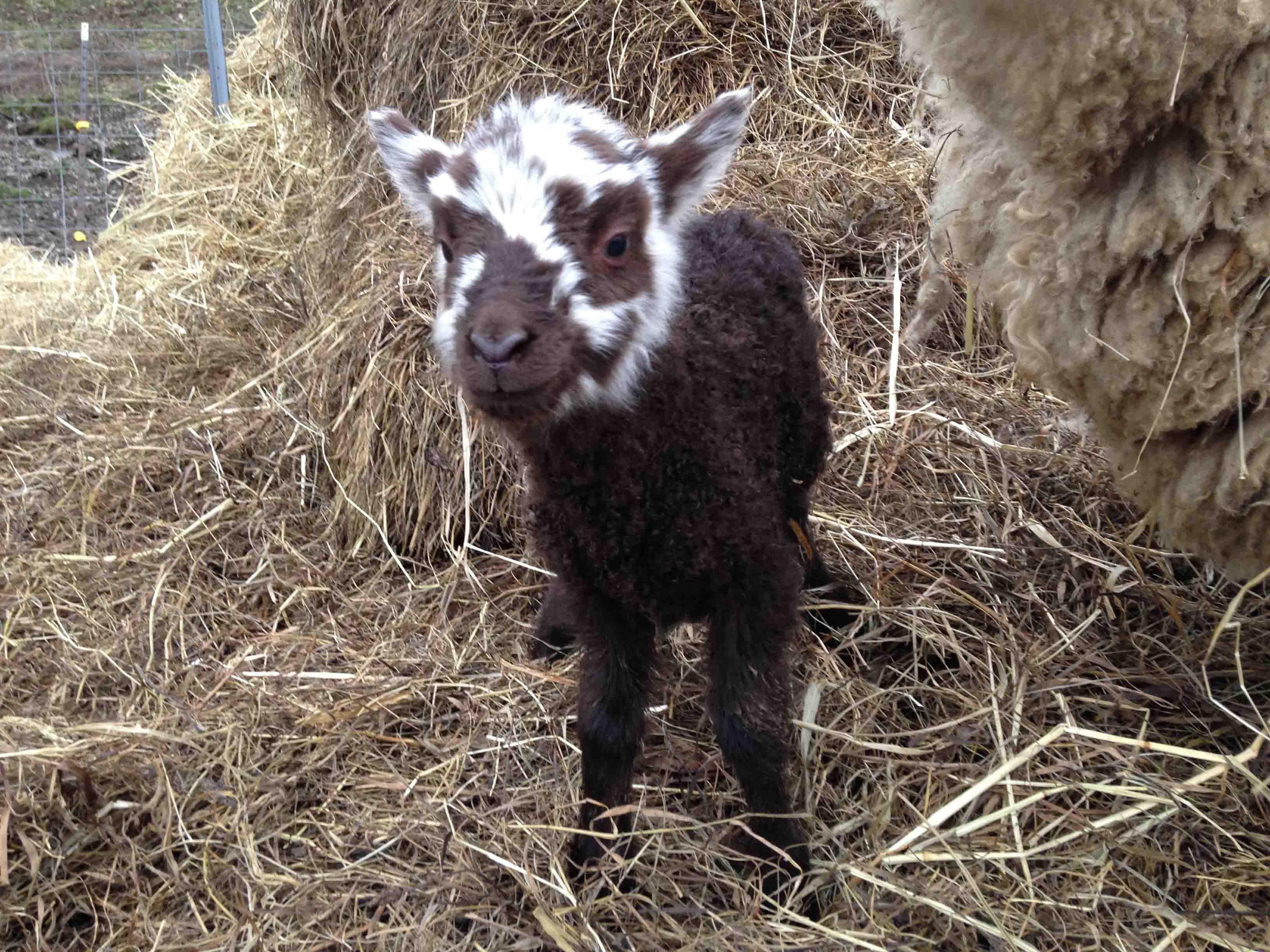
Lambs may appear one color when born and turn out (at their first shearing) to be an entirely different color. Or they may start out flashy, like this one.
Shearing
Many Shetland sheep naturally “roo” their wool. That means their wool naturally breaks off and they “shed.” That’s a necessary trait for a sheep living in the wild, but not desirable when the wool is intended for use.
Not all Shetlands roo and for a sheep’s health, the wool must come off, at least once a year, preferably in the spring. Unless there are other sheep operations nearby, it’s tough getting a shearer to come out for a handful of sheep. As luck would have it, there are only hair sheep near us so I am not only the shepherdess but the shearer too.
I’ve watched enough Youtube videos to know I am not talented enough to keep a sheep on its butt and shear at the same time. My sheep stand, tied up. I used hand shearers for a while but found I can do a better job with my big sewing scissors. I’m certainly not fast (20-30 minutes a sheep) but I get the job done. It’s not rocket science — anyone can do it, even if they are slow. Start at the butt and work forward. Take care around the flank and elbows. Make sure you can see the udders or penile sheath — you don’t want to accidentally cut them.
Breeding and lambing
We never separate our rams from the ewes and, even though Shetland sheep can breed twice a year, ours have only bred once a year. We always have spring lambs. If you want to plan your lambing schedule, know that ewes are in heat 28 hours, with a 16-17 day cycle. Gestation period is 148 to 152 days.
Because our ram runs with our ewes year round, we don’t know exact breeding dates, however, daily checks on our ewes usually show when lambing is imminent. Our ewes stay with the flock and are great moms. The rams are indifferent to the lambs and we’ve never had a ram be aggressive with a lamb.
Rams are not nice guys
Rams tend to be combatant in the fall rut season, but they can be dangerous any time. Don’t be fooled by their small size — they pack quite a wallop. If they get you down, they back up and charge, again and again. They can destroy the ligaments of your knee in one hit — and easily kill a child.
Always be cautious when in a pen with a ram. Never turn your back on them, and make sure there’s a free path to exit. Keep something between you and the ram. If you have a good stock dog, keep them with you too.
We never handle the rams. We love on the girls, but rams only get touched when we vet or shear them. This means they are flighty and scared of us. That sounds counter-intuitive, but a ram that is your buddy thinks you’re just part of the flock and therefore subject to being treated like one of the flock. If you displease the leader of the flock (and that can simply mean you aren’t carrying grain when he wants it) you get slammed.
Forget any ideas of punishing a spoiled ram — you’re not going to “beat” it out of them. Rams that are bad boys only during rutting season get a pass. I tie a bandana around the horns, so it hangs down over the eyes — they can see down, but not in front, eliminating their ability to charge me. Rams that are mean go in the freezer — I don’t want to breed lambs that have bad dispositions.
Earning their keep
Shetland sheep have a longer growing period to reach a good slaughter weight, compared to modern “improved” breeds. They are also a small sheep so the cuts will be on the small side. Even so, they are quite tasty and I’ve sold many of them for slaughter — and had many repeat customers.
The most obvious source of income from Shetland sheep is their wool to handspinners. The wool is also good for wet felting and needle felting projects — such as dryer balls and felt covered soaps. Pelts are also popular.
Resources
The best resource for more information and a list of breeders for Shetland sheep is the North American Shetland Sheepbreeders Association (NASSA) at https://www.shetland-sheep.org/.
For more general information on sheep, check with your veterinarian and your local or state extension service. If you have children, get them in 4-H, if possible (https://4-h.org). Sheep projects will teach your children (and you) valuable sheep-keeping information and connect you to other shepherds in your local area.
Shetland sheep are more common than ever in the United States, but typical 4-H sheep are often the size of a small pony. The small Shetlands often cause quite a stir (and some chuckles) at the county fair. Be a good sport, be willing to laugh at yourself a bit, and you’ll have opportunities to teach others about your amazing sheep. By the end of our county fair, a number of the “big sheep” 4-H kids were stopping by our sheep pen just so they could carry a lamb around.
Perfect homestead sheep
Shetland sheep aren’t perfect, but I think they are the perfect homestead sheep. Few, if any, other sheep breeds will offer the almost trouble-free care and easy-going nature of the Shetland sheep. Their lovely and versatile wool is perfect for selling or crafting/spinning projects — as well as soft, warm clothing. Besides, what homestead is complete without the pastoral scene of a flock of fluffy sheep grazing on the hillside of your pasture?

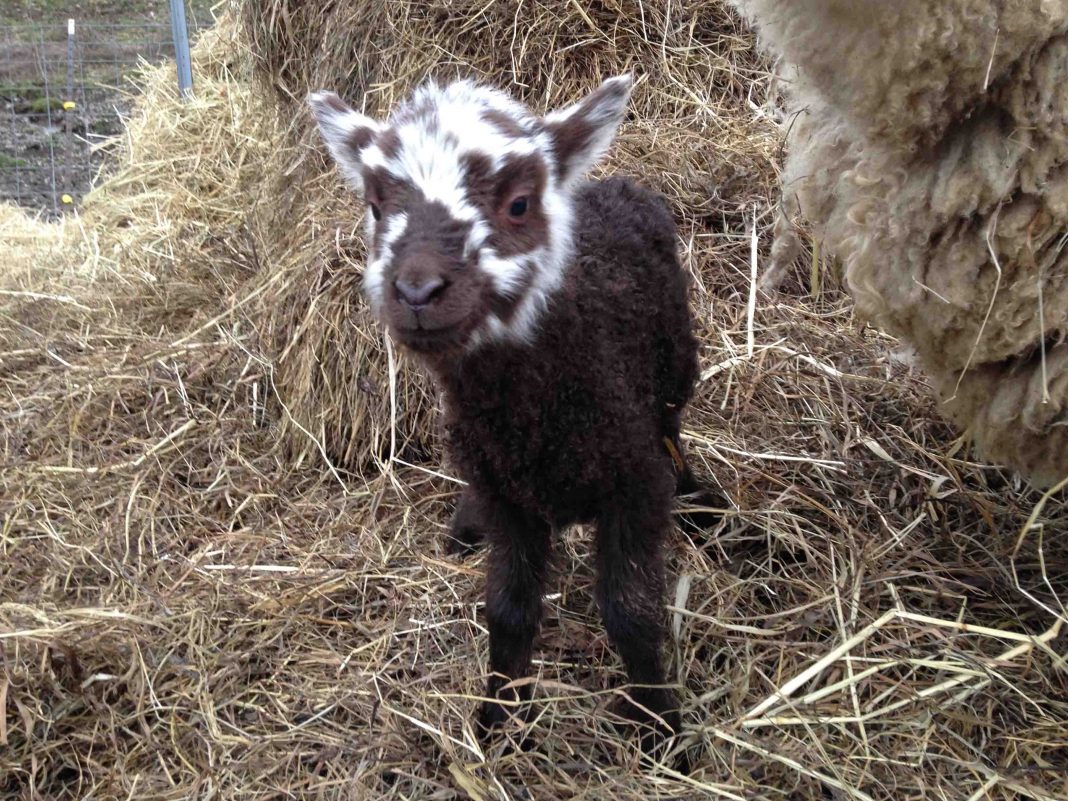
Well we have 15 rams and 40 some ewes we tend rams go in to get tured into food, ewes we keep for breed and we also keep three rams at all times, thing about rams is you need to not pair them you need odd numbers, if you only have one or only have two they will fight and ram stuff they get upset you dont can males with females at all times you sperate to keep unwanted preggers from happening.. which is issue with rams if only have one and you separate the ram will become upset and start destroying stuff sheep do not do good on their own same with rams they are herd animals and they need social contact with there own kind, also RAMs if you the are young and you handle them alot feed them by bottle so forth they will actually be very gentle animals, if you have only two rams, we noticed on our farm they will head but each other alot, if you have one two rams that are not fixed and one ram that is they will have issues, if you have two rams that are fixed and one ram that is not they have issues we found it best to always have pairs of three, if there paired in threes they keep each other in check and they do not fight or head butt as often..
but they are sheep and sheep head but even the ewes do it but keeping rams in pairs of three we have never lost a door or had issue of rams destroying anything or being mean ever not in the 15 years that we have had Shetlands.
Icelandic sheep have nice wool and they love to eat all the stuff other animals won’t eat.
It cannot be self-reliant if you have to have a third party come and vaccinate the sheep yearly.
A true self-reliant sheep does not need vaccines. There are plenty of such flocks out there.
Good to know about the rams, I’m SO GLAD I found this article, as I’ve never kept sheep before and I have a very small grandson!!! I will be sure that he never enters my sheep’s pen without his best buddy at his side, a male Kuvasz with whom he grew up with!
Thanks for the interesting article. I’m changing up from a commercial flock of white dorpers to a few shetlands.
The rooing is said to be an unwanted property in Shetland sheep… but I know that isn not true!
Rooing gives perfect fibers for handspinning and never has rendered a lesser quality than shearing does. Rooed fleeces need shorter preparation time and will have no prts to discard.
I have 6 Shetland wethers and they are the sweetest! I love the rooing trait, and as a hand spinner, I truly value the quality of the fiber when rooed rather than shorn. When rooed, each fiber has a natural taper to each end, the growth end and the rooed end, whereas the shorn fiber has a blunt cut at one end. These are slightly prickly. It is a very small prickle, but cumulatively, it makes the yarn slightly less soft than the same product when rooed.
2 notes on this article :
1. there are breeds of sheep that need more copper, Shetlands are in that group!
2. Rooing is an old wanted trait, because where they come from metal was non-existant and thus a costly import for a very poor region. Rooing is not the same as shedding on its own, you want to take it of before it falls off and blows away into the sea (Shetlands are an island sheep), but not need tools to do so.